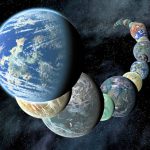The Rare Earth equation is Ward and Brownlee’s riposte to the Drake equation. It calculates N, the number of Earth-like planets in the Milky Way having complex life forms, as:
N = N* × fp × fpm × ne × ng × fi × fc × fl × fm × fj × fme
Here N* is the number of stars in the Milky Way galaxy, fp is the fraction of stars with planets, fpm is the fraction of planets that are metal-rich, ne is the average number of planets in the star’s habitable zone, ng is the number of stars in the galactic habitable zone, fi is the fraction of habitable planets where life does arise, fc is the fraction of planets where complex metazoans arise, fl is the fraction of the total lifetime of the planet that is marked by the presence of complex metazoans, fm is the fraction of planets with a large moon, fj is the fraction of solar systems with Jupiter-size planets, and fme is the fraction of planets with a critically low number of extinction events. In the rest of this column, I want to discuss the terms in this Rare Earth equation one by one, and then discuss some of the other factors not in the equation that may turn out to be important.
N*(stars) – Estimating the number of stars in the Milky Way galaxy is tricky, because we don’t know our galaxy’s mass very well, and there is little information about the population of very small stars. N* is roughly 500 billion stars of all classes.
fp (planets) – In 1995 astronomers discovered the first planets orbiting other stars. Since then more and more planets have been discovered. However, it is not clear what fraction of the stars in the galaxy actually have sizable planets.
fpm (metal) – One interesting correlation stands out among the existing observations of extra-solar planets. All of the observed planets orbit metal-rich stars. This suggests that planets, or at least planets large enough to have been observed so far, may not be all that common and may be peculiar to the subset of stars that are rich in metals.
ne (habitable zone) – The orbit of Earth happens to be “just right”, falling in a narrow habitable zone of orbit distances in which a planet not only has liquid water now, but also had liquid water several billion years ago when the Sun was cooler and life first formed. W&B mention a 1993 estimate indicating that if Earth’s orbit was 5% smaller or 15% larger it would not be in this habitable zone. This zone shrinks for more massive stars because of their more rapid evolution and for less massive stars because the zone of liquid water itself in narrower. Thus the average number of planets in habitable zones, averaged over all stars in the galaxy may be very small indeed.
ng (galactic zone) – The Solar System is about 25,000 light years from the galactic center, roughly a third of the distance from the center to the outside edge. This position is fortunate. Stars too close in have too may close neighbors that disturb the system’s orbits, too much fireworks from neighbor supernovas, and too much radiation that comes from the galactic center. Stars too far out are too deficient in the heavy elements cooked up in supernovas near the galactic center.
fi (life) – W&B suggest that the fraction of habitable planets where life does arise, at least in the form of bacteria, may be large. Geological evidence suggests that bacteria were present on the Earth as early as planetary conditions made it possible for them to exist. This view is also supported by observation of living bacteria from rock extracted from very deep wells and mines. The controversial claim that bacteria fossils may have been observed in meteorites of Martian origin found in the Antarctic, if true, also supports this idea.
fc (complex metazoans) – W&B argue that the fraction of planets with bacterial life where complex metazoans arise may be very small. They base this view on the observation that for four fifths of the time since life first appeared on the Earth, some 2.5 billion years ago, there was only bacterial life. They also point out that the Cambrian Explosion, when complex metazoans first appeared, was preceded by some extraordinary climactic and geological events that may have triggered it.
fl (planet lifetime) – Even if complex metazoans arise, their development, as indicated above, may take a long time. Finding complex life on another planet depends on the size of this time window.
fm (large moon) – Except for the Earth’s moon, the satellites of the Solar System have only a tiny fraction of the mass of their primary. Mercury and Venus have no satellites at all. The moons of Mars, Phobos and Demios, are small rocks with masses of only 27 and 5 billionths of the mass of Mars. Even the rather large moons of Jupiter and Saturn have masses of only a few parts in 105 of their planet’s mass. Our Moon, on the other hand, has 1.2% of Earth’s mass. This raises the question of how Earth could have acquired such a large satellite. The prevailing explanation is that a random collision occurred between the just-forming Earth and a Mars-size object, with Earth capturing most of the mass from that collision while about 1% of the debris coalesced into our Moon. Such an event is very unlikely, which suggests that most Earth-size planets will not have moons with anything approaching 1% of the planet’s mass.
An important consequence of our giant Moon is that it stabilizes the 23º tilt of the Earth’s rotational axis with respect to its orbital plane. Geological evidence indicates that over many millions of years the tilt of the Earth’s axis has stayed within a few degrees of its present value. Recent calculations have shown that without the Moon, the gravitational effects of Jupiter and the Sun would have caused the Earth’s tilt to wander chaotically over a wide range, producing enormous changes in climate and a hostile environment for the development of complex life.
fj (Jupiter) – W&B argue that if Jupiter (300 times more massive that Earth) were removed from the Solar System, the frequency of comet and asteroid impacts on the Earth would increase by a factor of about 10,000. A major asteroid strike capable of significant extinction of species is estimated to occur in an average time interval of about 100 million years. If Jupiter were not present or was in a significantly different orbit, this interval might increase to one strike every 10,000 years, impeding the development of complex life.
fme (extinctions) – Since the evolution of bacterial life on Earth some 2.5 billion years ago, there have been no extinction events large enough to sterilize the planet. W&B argue that this critically low number of extinction events may be unusual. The fossil record shows that there have been some very severe events, the most recent of which was the asteroid strike 65 million years ago that killed the dinosaurs as well as much of the life in the oceans. W&B argue that a very stable planetary system is required, which nearly circular orbits for all of the outer planets, for this condition to exist. An accident such as the gravitational perturbation of a passing star could easily destroy this delicate stability.
The Rare Earth equation, unlike the Drake equation, does not factor the probability that complex life evolves into intelligent life that discovers technology (Ward and Brownlee are not evolutionary biologists). There are a number of odds in the evolution process, for example, the large brains of humans have marked adaptive disadvantages, requiring as they do an expensive metabolism, a long gestation period, and a childhood lasting more than 25% of the average total life span. Other improbable features of humans include:
- Being the only extant bipedal land (non-avian) vertebrate. Combined with an unusual eye–hand coordination, this permits dextrous manipulations of the physical environment with the hands;
- A vocal apparatus far more expressive than that of any other mammal, enabling speech. Speech makes it possible for humans to interact cooperatively, to share knowledge, and to acquire a culture;
- The capability of formulating abstractions to a degree permitting the invention of mathematics, and the discovery of science and technology. Only recently did humans acquire anything like their current scientific and technological sophistication.








